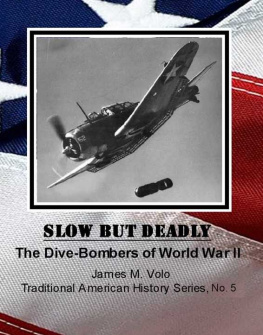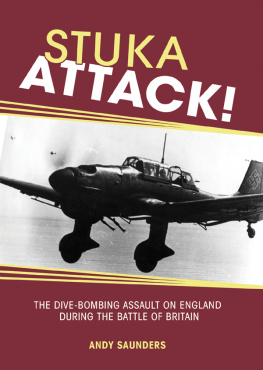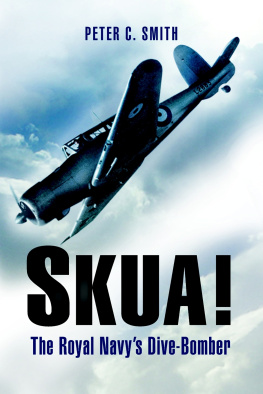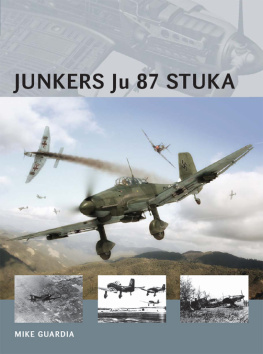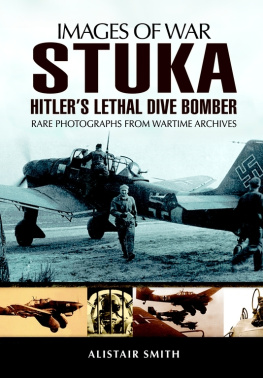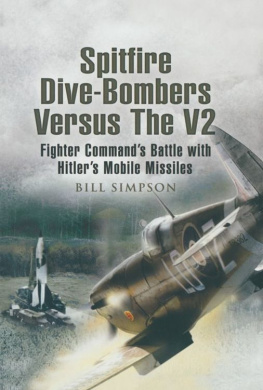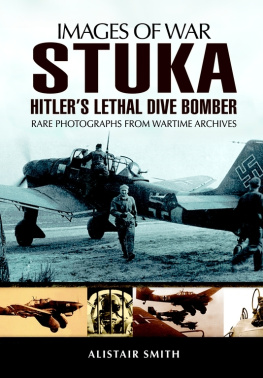Dr. Jeffrey L. Ethell
This book began as an original paper written by the author for Dr. Ethell at American Military University in 1996. On June 6, 1997, Jeffrey L. Ethell was killed when the vintage P-38 "Lightning" fighter plane he was piloting crashed near Tillamook, Oregon.
Slow But Deadly
The Dive-Bombers of World War II
James M. Volo
The day has passed when armies on the ground or navies on the sea can be the arbiter of a nation's destiny in war. The main power of defense and the power of initiative against an enemy has passed to the air.
Gen. Wm. Billy Mitchell, 1918
Introduction
Near the end of World War II in Europe, in March 1945, the last newsreel footage was taken of a Luftwaffe aircraft in combat action near the Oder River in Poland. With a siren screaming like a banshee, the lone Ju-87G Stuka made strafing runs on a group of Soviet tanks, the bursts of fire from its wing-mounted anti-tank guns appearing as puffs of smoke from its undercarriage as one of the tanks is destroyed. It is ironic that this Stuka should be the last Luftwaffe aircraft to be filmed. The aircraft type that made its lone attack on the Soviets in 1945 had opened its war service in 1939 when swarms of Ju-87s had bombed a bridge defense on the Vistula River as part of Hitlers initial invasion of Poland. Considered obsolete in 1945its numbers dwindled to a handful of serviceable machinesthe type was still flying in combat a decade after it had first been deployed as a weapons platform against land and sea targets.
The dive-bombing Ju-87 type built by Junkers of Dresden had become the symbol of German airpower. It had been designed in 1933, deployed in 1935, tested in combat during the Spanish Civil War (1936-1939), had helped to demolish the armies of Poland and France, had scourged the retreating British on the beaches at Dunkirk, destroyed the navies of its victims in the fjords of Norway and in the Baltic, savaged Crete, Greece, and the Balkans, supported Axis ground forces in the deserts of North Africa, and become of tank killer in the snows of the Eastern front. The sound of a Stukas wailing siren became so synonymous in the public imagination with diving aircraft that it was often heard overlaid on movie and newsreel soundtracks whenever a plane was descending rapidly or even when it was falling in flames. The German Ministry of Public Enlightenment and Propaganda stoked the Stuka madness that had possessed the people, and said that where the Stukas of the Luftwaffe led, the infantry and tanks of the Wehrmacht followed.

A lone Stuka amid the rubble of war over Warsaw
This was generally true during much of World War II. An estimated 6,500 Stukas were built between 1936 and 1945. Nonetheless, the slow moving but deadly Stuka had proved vulnerable to Allied fighter planes and ground fire. Vast numbers of slow moving Stukas had fallen victim to British Hurricanes and Spitfires in the Battle of Britain. It was like running a Ford Model T at the Indy 500, and the Stukas had been removed from daylight operations on the Western front in 1943. They continued in action elsewhere, and were successful wherever enemy fighter aircraft were less advanced.

The Stuka appeared on Nazi Postage stamps in 1943.
The theme of this book is the exploration of the theory and practice of dive-bombing, which tactic proved more precise than that of level-flight bombers and more effective than air-launched torpedo attacks against surface ships. It is also the authors purpose to come to a more general conclusion as to the effectiveness of dive-bombing under actual combat conditions. In this regard the words and observations of several dive-bomber aviators have been incorporated. While the best known dive-bomber was the Stuka, the most successful of the major dive-bombing airframes was undoubtedly the American-made Douglas SBD Dauntless that would prove (like most of its type) to be S low B ut D eadlyhence the title of this book. (See Appendix I)
The Aichi D3A1 Val dive-bombers and Nakajima B5N Kate torpedo planes of the Imperial Japanese Navy (IJN) that had attacked Pearl Harbor in 1941 would be set against the SBD Dauntless dive-bomber and Douglas TBD Devastator torpedo planes of the US Navy in a series of decisive naval air battles in 1942 in the Pacific. The SBDs would bring dive-bombing theory and practice together with remarkable efficiency. While the primary operational focus of these discussions will surround the numerous carrier v. carrier battles in the Pacific between the navies the Empire of Japan and the United States from May to November 1942, it will also deal with operations and observations made in other theaters and periods of WWII that shed light on the evolution and practice of dive-bombing on land. With these parameters in mind, several designs of dive-bombing airframesUS, UK, Japanese, German, etc.will be used to highlight developments specific to dive-bombing and the evolution of the dive-bombing mission.
Those interested souls, who wish first to visit the details of the battles in which the Dauntless figured so prominently beginning in May 1942 at Midway, might scroll to the section of this work entitled In Combat, May-November 1942 . However, they should be advised that they would miss much in the interim that will make the telling of those tales more meaningful. As Benjamin Franklin wrote, He that can have patience will have what he will. Nonetheless, even the impatient reader should return to the intervening chapters of this book for a fuller understanding of the significance of dive-bombing to victory in World War II.
Conflicting Views
William Billy Mitchell had served as a American Expeditionary Force pilot in France during World War I. At the close of the war in 1918, he was appointed deputy director of the nascent American Air Service (an offshoot of the US Army and predecessor of the Army Air Corps) and began advocating increased investment in air power, believing that this would prove vital in future wars. He argued particularly for the ability of bombers to sink battleships, and he organized a series of strictly orchestrated bombing demonstrations against stationary ships designed to test the idea in 1921. Chief among these ships was an obsolete German battleship, Ostfriesland . One day of scheduled 230, 550 and 600 lb (270 kg) bomb attacks by Marine, Navy, and Army aircraft settled the Ostfriesland three feet by the stern with a five-degree list to port. On the next day, five Martin NBS-1 night bombers dropped a single 1,100 lb (500 kg) bomb each, scoring three direct hits. The ship was still afloat. The Navy wanted to stop further drops in order to assess the damage, although the Army bombers had nine bombs remaining. At this point, 2,000 lb (910 kg) bombs were loaded and a flight of NBS-1s dropped six bombs in quick succession. There were no direct hits but three of the bombs landed close enough to rip apart the hull plates and cause the ship to roll over. At the time, Mitchell was in the air in his own plane supervising the tests.

